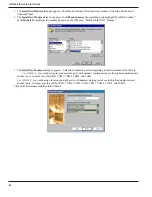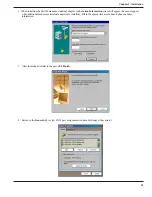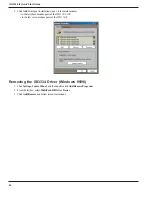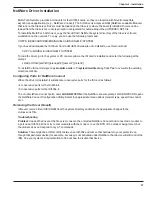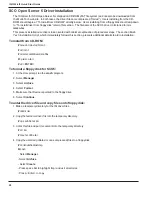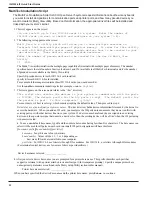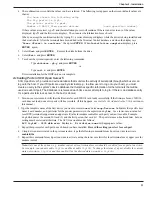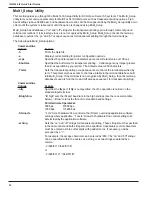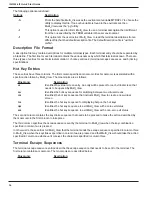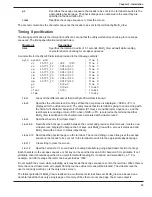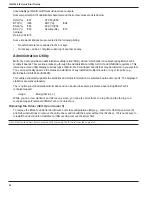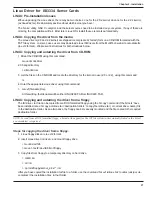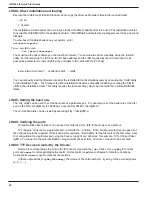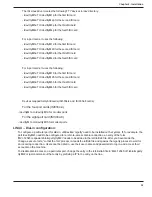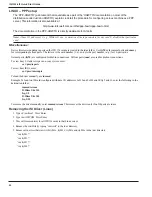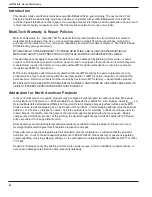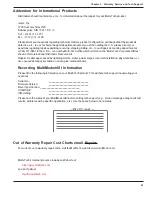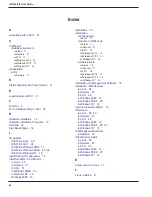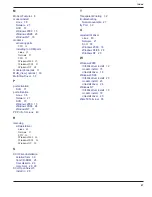
ISI3334-4/8 Quick Start Guide
38
LINUX: Driver installation and loading
Execute the 'Install' script to build the driver and to copy the driver and firmware files to the required folder.
> cd /isi
> ./Install
The installation script requires the user to type in the I/O address and the IRQ to be used. The installation creates
the script file 'ISICOMStart' in the destination folder. 'ISICOMStart' automates the loading process for the driver and
firmware.
To view busy I/O address space on your system, enter
cat/proc/ioports
To view busy IRQs, enter:
cat /proc/interrupts
You must load the driver before you can load the firmware. You can load the driver manually using the 'insmod'
utility. For ISI cards with the ISA bus, the I/O base address and the IRQ required by the card also need to be
passed as parameters to insmod (this does not apply to ISI cards with the PCI bus).
insmod isicom io=card1, ... card4 irq=card1, ... card4
You can manually load the firmware into all of the installed ISI cards simultaneously by executing the 'frmld' utility
in the installation folder. The firmware to all the installed cards can be manually loaded by executing the 'firmld'
utility in the installation folder. This utility requires the firmware files (.bin) to be located in the /usr/local/ISICOM/
folder.
LINUX: Setting the baud rate
The 'stty' utility can be used to set the baud rate of a particular port. For example, to set the baud rate of the first
port on the first card (ttyM1a) to 38400 bps, execute 'stty 38400 < /dev/ttyM1a'.
The current baud rate can be viewed by executing 'stty < /dev/ttyM1a'.
LINUX: Verifying the ports
Terminal utilities like 'minicom' can be used to verify the ports, 'talk' to the modem, and dial out.
To configure 'minicom' for a particular port, run it with the '-s' option. In the 'serial port setup' menu option, set
the serial device to the required ISI port device (for example, '/dev/ttyM1a' for the first port on the first card). Save
the configuration for a particular port using the 'save setup as' menu option as, for example, '1a' for the port /dev/
ttyM1a. To connect to the port /dev/ttyM1a using minicom the next time, 'minicom 1a' needs to be executed.
LINUX: TTY Devices Created by the Drivers:
Device files corresponding to ports on the ISI card are created in the
/dev
folder. Use
ttyMxy
for normal
ports and
cumxy
for corresponding callout ports. Normal ports (
ttyM
) are configured for dial-in connections.
Callout ports (
cum
) are used for dial-out connections.
In these expressions (
ttyMxy
and
cumxy
), the letter
x
is the card number (1-4), and
y
is the port designator
(a, b, c, ...).
Summary of Contents for MultiModem ISI ISI3334/4
Page 5: ...Chapter 1 Introduction and Description ...
Page 8: ...ISI3334 4 8 Quick Start Guide 8 ...
Page 9: ...Chapter 2 Installation ...
Page 41: ...Chapter 3 Service Warranty Tech Support ...
Page 44: ...ISI3334 4 8 Quick Start Guide 44 ...
Page 45: ...Index ...

